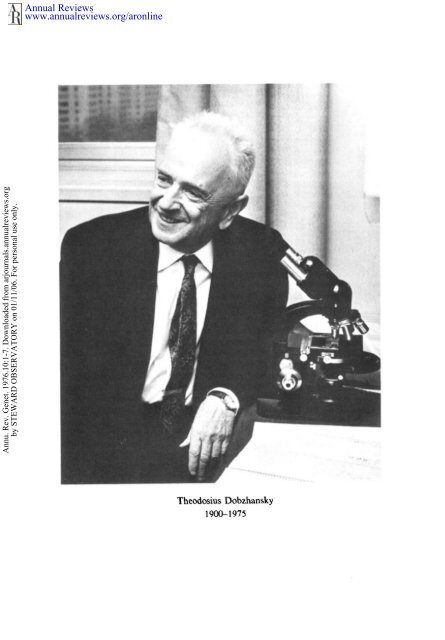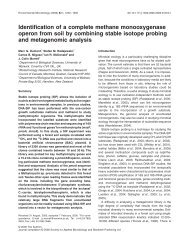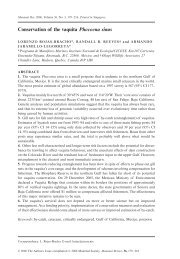Theodosius Dobzhansky: The Man and the Scientist
Theodosius Dobzhansky: The Man and the Scientist
Theodosius Dobzhansky: The Man and the Scientist
You also want an ePaper? Increase the reach of your titles
YUMPU automatically turns print PDFs into web optimized ePapers that Google loves.
Annu. Rev. Genet. 1976.10:1-7. Downloaded from arjournals.annualreviews.orgby STEWARD OBSERVATORY on 01/11/06. For personal use only.Annual Reviewswww.annualreviews.org/aronline<strong><strong>The</strong>odosius</strong> <strong>Dobzhansky</strong>1900-1975
Annual Reviewswww.annualreviews.org/aronlineAnn. Rev. Genet 1976. 10:1-6Copyright © 1976 by Annual Reviews Inc. All rights reservedAnnu. Rev. Genet. 1976.10:1-7. Downloaded from arjournals.annualreviews.orgby STEWARD OBSERVATORY on 01/11/06. For personal use only.THEODOSIUS DOBZHANSKY:THE MAN AND THE SCIENTISTFrancisco J. AyalaDepartment of Genetics, University of California, Davis, California 95616<strong><strong>The</strong>odosius</strong> <strong>Dobzhansky</strong> was born on January 25, 1900, in Nemirov, a small townin <strong>the</strong> Ukraine 200 kilometers sou<strong>the</strong>ast of Kiev. He was <strong>the</strong> only child of GrigoryDobrzhansky, ~ a teacher of high school ma<strong>the</strong>matics, <strong>and</strong> Sophia Voinarsky. In1910 <strong>the</strong> family moved to <strong>the</strong> outskirts of Kiev, where <strong>Dobzhansky</strong> lived through<strong>the</strong> tumultuous years of <strong>the</strong> Bolshevik revolution <strong>and</strong> <strong>the</strong> First World War. Hegraduated in biology from <strong>the</strong> University of Kiev in 1921, <strong>and</strong> from 1921 to 1924taught zoology at <strong>the</strong> Polytechnic Institute. From 1924 to 1927 he was a lecturerin genetics at <strong>the</strong> University of Leningrad.In 1927, <strong>Dobzhansky</strong> obtained a fellowship from <strong>the</strong> International EducationBoard (Rockefeller Foundation) <strong>and</strong> arrived in New York on December 27 in orderto work with Thomas Hunt Morgan at Columbia University. In <strong>the</strong> summer of 1928he followed Morgan to <strong>the</strong> California Institute of Technology where <strong>Dobzhansky</strong>was appointed assistant professor of genetics in 1929, <strong>and</strong> professor of genetics in1936. <strong>Dobzhansky</strong> returned to New York in 1940 as professor of zoology at ColumbiaUniversity, where he remained until 1962, when he became professor at <strong>the</strong>Rockefeller Institute (renamed Rockefeller University in 1965) also in New YorkCity. On July 1, 1970, <strong>Dobzhansky</strong> became emeritus at Rockefeller University; inSeptember 1971 he moved to <strong>the</strong> Department of Genetics at <strong>the</strong> University ofCalifornia, Davis, where he was adjunct professor until his death in 1975.On August 8, 1924, <strong>Dobzhansky</strong> married Natalia (Natasha) Sivertzev, a geneticistin her own right, who at <strong>the</strong> time was working with <strong>the</strong> famous Russian biologistI. I. Schmalhausen in Kiev. Natasha was <strong>Dobzhansky</strong>’s faithful companion <strong>and</strong>occasional scientific collaborator until her death by coronary thrombosis on February22, 1969. <strong>The</strong> <strong>Dobzhansky</strong>s had only one child, Sophie, who is married toMichael D. Coe, Professor of Anthropology at Yale University.~3097~Precise transliteration of <strong>the</strong> Russian family name includes <strong>the</strong> letter "r".
Annual Reviewswww.annualreviews.org/aronline4 AYALAAnnu. Rev. Genet. 1976.10:1-7. Downloaded from arjournals.annualreviews.orgby STEWARD OBSERVATORY on 01/11/06. For personal use only.papers investigate local <strong>and</strong> geographic variation in <strong>the</strong> color <strong>and</strong> spot pattern oftwo Coccinellidae genera, Harmoni<strong>and</strong> ~4dalia. <strong>The</strong>se ladybird beetles exhibitlocal polymorphisms, which in some species vary from one to ano<strong>the</strong>r locality.<strong>Dobzhansky</strong> explained <strong>the</strong> genetic variation within <strong>and</strong> between populations as <strong>the</strong>consequence of <strong>the</strong> same fundamental evolutionary processes. Some cardinal <strong>the</strong>mesof <strong>Dobzhansky</strong>’s evolutionary <strong>the</strong>ory are present in this work: <strong>the</strong> pervasiveness ofgenetic variation, geographic variation as an extension of local polymorphism, <strong>and</strong>as <strong>the</strong> first, but reversible, step towardspecies differentiation. <strong>Dobzhansky</strong> continued<strong>the</strong> study of natural populations of ladybird beetles until he left Russia in 1927.He occasionally worked with coccinelids in <strong>the</strong> United States (e.g. a 94 page monographpublished in 1941).<strong>The</strong> beginning of <strong>Dobzhansky</strong>’s studies on <strong>the</strong> population genetics of Drosophilacan be traced to 1933 when he published a paper on <strong>the</strong> sterility of hybrids betweenD. pseudoobscur<strong>and</strong> D. persimilis (<strong>the</strong>n known as D. pseudoobscura race B). Ina series of papers, he investigated <strong>the</strong> physiological, developmental, <strong>and</strong> geneticcauses of hybrid sterility. This work developed from <strong>the</strong> convergence of two independentprevious lines of investigatio.n, <strong>the</strong> genetics of translocations <strong>and</strong> <strong>the</strong> studyof sex determination. It led, in 1935, to <strong>the</strong> formulation of <strong>the</strong> concept of (sexuallyreproducing) species still accepted today: "that stage of <strong>the</strong> evolutionary process atwhich <strong>the</strong> once actually or potentially interbreeding array of forms becomesegregatedin two or more separate arrays which are physiologically incapable of interbreeding."This notion establishes that reproductive isolation is what sets speciesapart. It is also an evolutionary definition that sees speciation as a dynamic processof gradual change. In 1937 <strong>Dobzhansky</strong> coined <strong>the</strong> term isolating mechanisms (Am.Nat. 71:404-20) to designate <strong>the</strong> phenomena that impede gene exchange betweenspecies. He identified, classified, <strong>and</strong> investigated <strong>the</strong> various kinds ,of isolatingmechanisms. Isolating mechanismsone example of <strong>the</strong> many useful terms coinedby <strong>Dobzhansky</strong> that have become part of <strong>the</strong> language of evolutionary biology.In a brief note it is possible to name only a few of <strong>the</strong> many problems of populationgenetics investigated by <strong>Dobzhansky</strong>: geographical, altitudinal, <strong>and</strong> temporal variationin <strong>the</strong> frequencies of chromosomal arrangements in natural populations; <strong>the</strong>occurrence of "concealed" variation, first of lethal genes <strong>and</strong> later of genes modifyingfitness components such as viability, rate of development, <strong>and</strong> fertility; <strong>the</strong> origin<strong>and</strong> evolution of sexual <strong>and</strong> <strong>the</strong> o<strong>the</strong>r reproductive isolating mechanisms; mutationrates, <strong>the</strong>ir genetic control, <strong>and</strong> <strong>the</strong> equilibrium between mutation <strong>and</strong> selection innatural populations; migration <strong>and</strong> dispersion rates; effective population size; correlationbetween genetic polymorphism <strong>and</strong> ecological heterogeneity; causes of speciesdiversity; heterosis; genetic load; coadaptation of gene pools; joint effects of selection,population size, <strong>and</strong> migration on traits with low heritability; <strong>and</strong> so on.Indeed, <strong>the</strong>re may be no major problem of population genetics to which <strong>Dobzhansky</strong>did not make important experimental contributions.Some characteristics of <strong>Dobzhansky</strong>’s research strategy that contributed to hisenormousuccess deserve mention. He worked both in <strong>the</strong> field <strong>and</strong> in <strong>the</strong> laboratory;whenever possible he combined both in <strong>the</strong> study of a problem, often usinglaboratory studies in order to ascertain or to confirm <strong>the</strong> causal processes involvedin phenomena discovered in nature. He obtained <strong>the</strong> collaboration of ma<strong>the</strong>mati-
cians in order to design <strong>the</strong>oretical models for experimental testing <strong>and</strong> to analyzestatistically his empirical observations. He was no inventor or gadgeteer, but he hadan uncanny ability to exploit <strong>the</strong> possibilities of any new experimental apparatus orexperimental method that suited him. He selected organisms that provided <strong>the</strong> bestmaterials to i~vestigate <strong>the</strong> problems that interested him: <strong>the</strong> biological particularitiesof D. pseudoobscura <strong>and</strong> its relatives, <strong>and</strong> of <strong>the</strong> D. willistoni group, madepossible many of <strong>Dobzhansky</strong>’s discoveries. He always worked at <strong>the</strong> utmost levelof genetic resolution possible at any given time: he took advantage of <strong>the</strong> earlymethods of genetic analysis, <strong>the</strong>n of various cytological tools, later of <strong>the</strong> giantpolytene chromosomes, <strong>and</strong> of <strong>the</strong> techniques to produce chromosomal homozygotes.When gel electrophoresis came about, he immediately recognized its enormouspotential as a ~tool to study population genetics problems; he felt that it wastoo late in his life for him to learn <strong>the</strong> technique but encouraged his students <strong>and</strong>collaborators to use it <strong>and</strong> collaborated in several projects using it.<strong>Dobzhansky</strong> was an extremely successful experimental scientist. Yet his mostsignificant contribution to biology was his establishment of <strong>the</strong> modern syn<strong>the</strong>sis ofevolutionary <strong>the</strong>ory. By <strong>the</strong> early 1930s <strong>the</strong> work of Fisher, Wright, Haldane, <strong>and</strong>Chetverikov had provided a <strong>the</strong>oretical framework integrating Mendelian geneticswith Darwin’s <strong>the</strong>ory of evolution. In Genetics <strong>and</strong> <strong>the</strong> Origin of Species (1937)<strong>Dobzhansky</strong> completed this integration in two ways. First he ga<strong>the</strong>red <strong>the</strong> empiricalevidence that supported <strong>and</strong> made acceptable <strong>the</strong> ma<strong>the</strong>matico-<strong>the</strong>orefical framework.Second, he extended <strong>the</strong> integration of Mendelism <strong>and</strong> Darwinism muchbeyond <strong>the</strong> range provided by <strong>the</strong> ma<strong>the</strong>matical models <strong>and</strong> produced a comprehensiveevolutionary <strong>the</strong>ory that carried population genetics up to <strong>the</strong> process of speciation<strong>and</strong> beyond. <strong>The</strong> modern <strong>the</strong>ory of evolution would continue to develop in <strong>the</strong>future, but it was born with <strong>Dobzhansky</strong>’s 1937 book in <strong>the</strong> same way as <strong>the</strong> original<strong>the</strong>ory had come about with Darwin’s Origin of Species in 1859.<strong>The</strong> single-most important empirical fact established <strong>and</strong> argued by <strong>Dobzhansky</strong>is <strong>the</strong> ubiquity of genetic variation. He was quick to see <strong>the</strong> momentous implicationsof this fact for mankind. <strong>Dobzhansky</strong> set forth that <strong>the</strong> individual is not <strong>the</strong> embodimentof some ideal type or norm, but ra<strong>the</strong>r a unique <strong>and</strong> unrepeatable realizationin <strong>the</strong> field of quasi-infinite possible genetic combinations. <strong>The</strong> pervasiveness ofgenetic variation provides <strong>the</strong> biological basis of human individuality. <strong>Dobzhansky</strong>evinced that it also leads to demystification of <strong>the</strong> much abused concept of race.<strong>Dobzhansky</strong> saw that an adequate underst<strong>and</strong>ing of human nature is only possiblein <strong>the</strong> light of evolution. In <strong>Man</strong>kind Evolving (1962) he expounds <strong>the</strong> implicationsof <strong>the</strong> <strong>the</strong>ory of evolution for mankind. This book remains an unsurpassed syn<strong>the</strong>sisof genetics, evolutionary <strong>the</strong>ory, anthropology, <strong>and</strong> sociology. <strong>Dobzhansky</strong>’s lastinginterest in <strong>the</strong> relevance of biology to human affairs is revealed in <strong>the</strong> titles of someof his books, such as Heredity, Race, <strong>and</strong> Society (1946, with L. C. Dunn), <strong>The</strong>Biological Basis of Human Freedom (1956), Heredity <strong>and</strong> <strong>the</strong> Nature of <strong>Man</strong> (1964),<strong>The</strong> Biology of Ultimate Concern (1967), Genetic Diversity <strong>and</strong> Human Equality(1973).<strong>Dobzhansky</strong> was a warm <strong>and</strong> compassionate man who had little patience withobscurantism, racial prejudice, or social injustice. In <strong>the</strong> 1940s <strong>and</strong> 1950s he publishedseveral articles criticizing Lysenko’s biological quackery. He attacked an-Annual Reviewswww.annualreviews.org/aronlineTHEODOSIUS DOBZHANSKY 5Annu. Rev. Genet. 1976.10:1-7. Downloaded from arjournals.annualreviews.orgby STEWARD OBSERVATORY on 01/11/06. For personal use only.
Annual Reviewswww.annualreviews.org/aronline6 AYALAAnnu. Rev. Genet. 1976.10:1-7. Downloaded from arjournals.annualreviews.orgby STEWARD OBSERVATORY on 01/11/06. For personal use only.tievolutionists <strong>and</strong> cogently rejected claims that Christian beliefs are incompatiblewith evolution. He relentlessly denounced what he called "bogus ’science’ of raceprejudice."<strong>Dobzhansky</strong> was a religious man, although he apparently rejected fundamentalbeliefs of traditional religion, such as <strong>the</strong> existence of a personal God <strong>and</strong> of lifebeyond physical death. His religiosity was grounded on <strong>the</strong> belief that <strong>the</strong>re ismeaning in <strong>the</strong> universe. He saw that meaning in <strong>the</strong> fact that evolution has produced<strong>the</strong> stupendous diversity of <strong>the</strong> living world <strong>and</strong> has in fact progressed fromprimitive forms of life to man. <strong>Dobzhansky</strong> beheld that in man biological evolutionhas transcended itself into <strong>the</strong> realm of self-awareness <strong>and</strong> culture. A metaphysicaloptimist, he believed that somehow mankind would eventually evolve into higherlevels of harmony <strong>and</strong> creativity.
Annu. Rev. Genet. 1976.10:1-7. Downloaded from arjournals.annualreviews.orgby STEWARD OBSERVATORY on 01/11/06. For personal use only.




